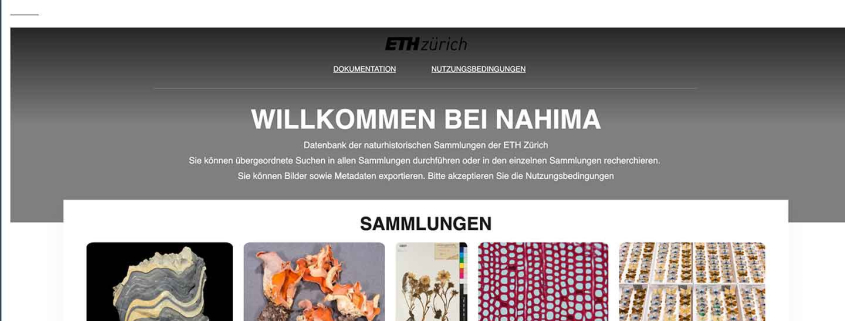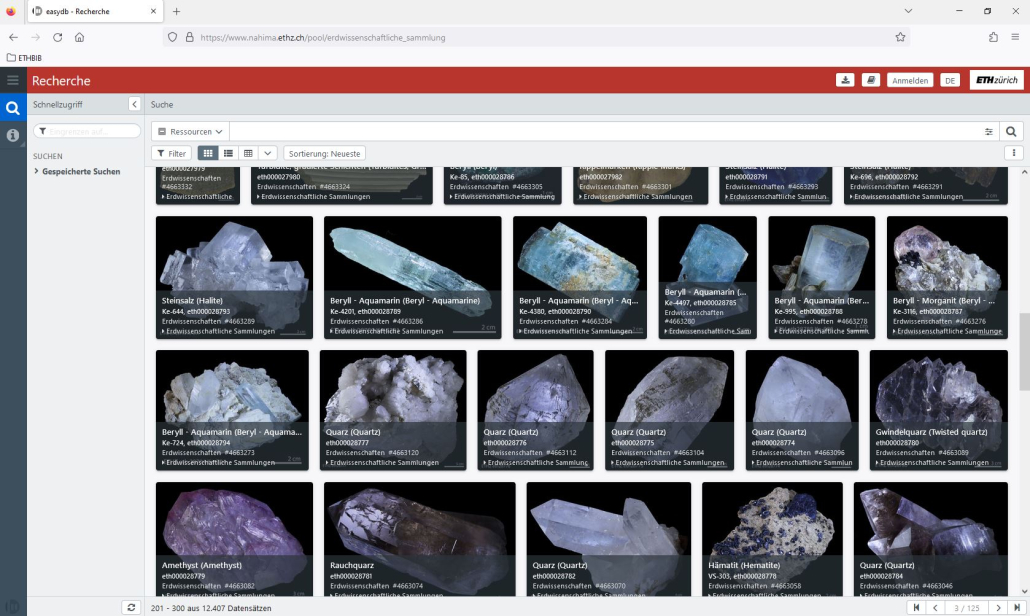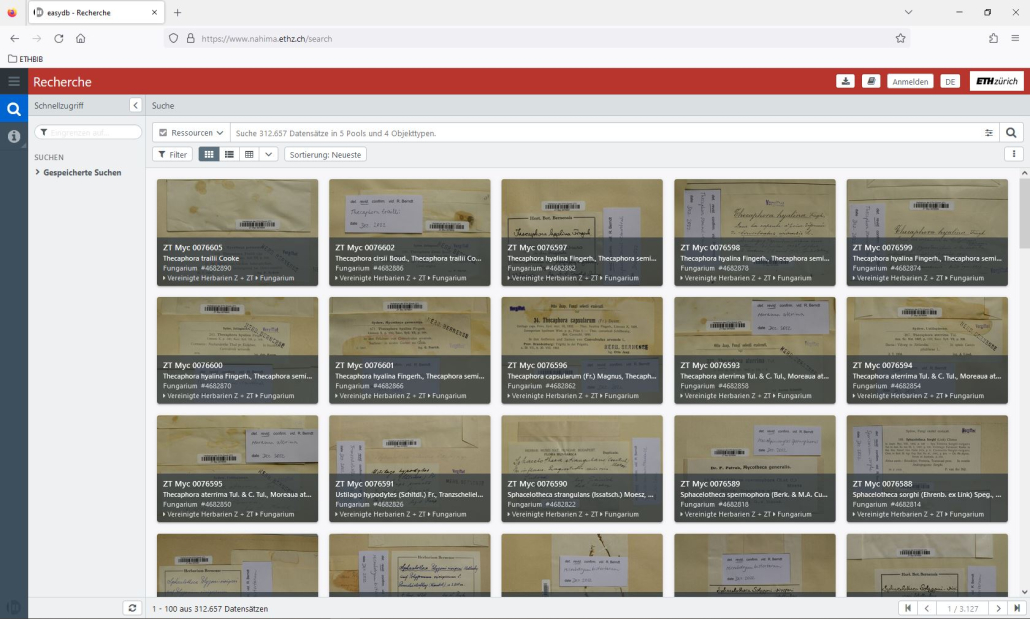THE NAHIMA project of the ETH Library
NAHIMA – Natural Science Collections online
The management and use of natural science collections poses a significant challenge that can be overcome easydb ETH Library's Management digitally) an efficient way to access reference specimens, discover plant and animal species, research biodiversity, and conduct climate studies. With over 530,000 records and almost 462,000 media (as of May 2023) from various collections such as Earth Sciences, Fungarium, Xylothek, and Entomology, NAHIMA provides a comprehensive database that centralizes collection management while serving as a window to the outside world.
The versatile use of NAHIMA for scientific collections
Until 2018, some of ETH Zurich's collections used their own solutions or worked with FileMaker. With the introduction of NAHIMA, this situation has changed fundamentally. The platform serves as a collectionmanagementtool for ETH's natural science collections. It also offers experts, students, and the relevant community the opportunity to access and explore the collections. By integrating authority files, lists of values for taxonomies, persons, and institutions, and comparing them with the Red List of Threatened Species, the system enables comprehensive exchange of data and metadata across various interfaces and formats.
NAHIMA has been implemented in five collections, each with different needs and usage priorities. The Xylothek, a collection of woodcuts, uses NAHIMA primarily as a platform for external presentation of the collection. The Earth Sciences and Fungarium, on the other hand, use NAHIMA extensively for their overall collectionmanagement. In the Earth Sciences, locations are currently being recorded, and completed projects are being implemented in the database. Another natural sciences collection is currently working on connecting its existing database to NAHIMA. Of the five collections, three are currently fully utilizing NAHIMA and benefiting from the extensive functions and efficient management offered by this database solution.
Key facts
- In use since: 2021
- Objects: 607,367 (as of May 2023)
- Images: 533,006 (as of May 2023)
Advanced features
- PDF Creator
Additional services
- Development of a special add-on: IUCN Plugin (connection to the IUCN Red List)
The unification of different collections: Paving the way for improvements in the initial project phase
A challenging task at the beginning of the project was to consolidate five different collections, each with their specific needs and workflows, into a harmonious set of requirements. Despite the initial challenges, this ambitious goal yielded valuable insights and paved the way for future improvements.
The requirements for the datamanagementsystem included:
- Centralization: The ETH Library sought a centralized system that could be used by all participating collections. The goal was to efficiently share resources and create management
- External accessibility: It was important that the system could also be used by outsiders. The ability to provide a link allowing access to the collections was considered desirable.
- Presentation of the collections: The data management system should offer the opportunity to adequately present the collections to the public. It should provide a platform where experts, students, and the relevant community could explore and use the collections.
The decision in favor of easydb was based on a public tender process. In addition to the software evaluation, the evaluation of the integration partner, in this case, Programmfabrik, also played a key role. The skills and expertise of the implementation specialist thus contributed to the decision. Ultimately, easydb best met the tender requirements and was therefore selected as the suitable solution.
How was the project implemented using easydb ?
The project to implement NAHIMA using easydb included setting up the database and migrating ETH's five collections. The PDF Creator extension was also integrated, allowing users to create custom layouts for PDF files. This allows, for example, the creation of well-formatted labels, which are essential for collection work.
Specific adjustments and configurations were made as part of the project. The IUCN Red List plugin (plugin = extension) is currently being adapted to the needs of the collections (as of May 2023). It is not yet in productive use. The IUCN Red List (Red List of the International Union for Conservation of Nature) is a globally recognized, comprehensive inventory that assesses and categorizes the endangered status of various animal and plant species to raise awareness of threatened species and promote conservation measures.
Shortly before the application went live, a project manager from Programmfabrik provided employees with training on how to use easydb. The training sessions were recorded, so employees can access the recordings and review the training content at any time.
The integration of easydb into existing systems and workflows was achieved through the connection to the ETH Library. The ETH Library now takes over the management and support of the collections when assistance is needed. This represents a new workflow, as previously each collection had its own internal database. The introduction of easydb and NAHIMA has centralized and optimized data management and collection management processes.
Increased efficiency, productivity and data security through the use of easydb in the NAHIMA project
The use of easydb in the NAHIMA project has resulted in several improvements in efficiency, productivity, and data security:
Efficiency
Centralized database : Centralized data storage in easydb makes accessing important Info faster and easier. This saves time and resources that would otherwise Search and consolidating data from various sources.
productivity
Independence from individuals : Because easydb is a service provided by the ETH Library, the system and thus all the knowledge remains dam even if key personnel leave the project. This promotes project sustainability and increases productivity.
Collection Visibility : Collections that had no visibility before Nahima benefit greatly from easydb as they are now open to external research and collaboration.
Data security
Continuous support : The system is continuously maintained, ensuring the security and integrity of the data.
Reliable visibility : Collections can be confident that their data is protected and accessible both internally and to external researchers. This is critical for research and contributes to data security.
Employee and customer feed on the use of easydb in NAHIMA: Successes and initial challenges
The Feed from employees and customers on the use of easydb in the NAHIMA project is overall positive, but there were also initial challenges:
Community Engagement : The fact that both the individual collections and the ETH Library have carried out marketing activities indicates a high level of commitment and positive expectations.
International cooperation : The interest of a US herbaria platform in integrating NAHIMA data demonstrates recognition of the collection's value and quality. This would greatly benefit the collections in terms of expanded reach.
Solution-oriented collaboration : The close and solution-oriented collaboration between the ETH Library and the collections has apparently led to positive Feed .
Initial skepticism : In the initial phase, collection staff expressed concerns about the new system. Despite questions about feasibility and functionality, the ETH Library consistently pursued a solution-oriented approach through close cooperation with the collections and the programmfabrik , for which it also received positive Feed .
Performance: The NAHIMA project implemented a comprehensive and complex data model combined with sophisticated rights management . The resulting initial delay in loading the system will be continuously improved over the course of the project.
Conclusion and outlook: The successful role of easydb in the implementation and future development of the NAHIMA project
The NAHIMA project at ETH Zurich has yielded important insights, particularly in the efficient management and use of scientific collections. The project has created a central database that facilitates access to a wide range of scientific datasets. Researchers now have efficient access to reference specimens and can conduct a wide range of studies in the fields of biodiversity and climate. Furthermore, the system enables comprehensive data exchange through the integration of authority files and comparison with the Red List of Threatened Species.
The use of easydb in the project was overall viewed positively. The software not only made data management more efficient but also improved productivity and data security. While there were some initial challenges and skepticism, these were overcome through close, solution-oriented collaboration between the ETH Library and the collections. Thus, easydb contributed significantly to the successful implementation of NAHIMA.
Future plans include the project's continuation and expansion. New features such as a 3D viewer are planned. The aim is also to integrate more collections, especially smaller ones with limited resources, into the system. The needs of the collections will be better understood and the project adapted accordingly.
Links to the NAHIMA project
Infofrom ETH Zurich/ETH Library about the project
Making curated knowledge accessible for generations
For 15 years, we have been an innovative pioneer in the field of web-based media repositories easydb fylr , the successor to easydb 5, customers rely on our experience and expertise in over 200 installations. Due to its scientifically oriented and customized approach, the system is particularly well-established in educational and research institutions and has become indispensable in over 50 press offices.
Our team of experts is available to answer your individual questions.




